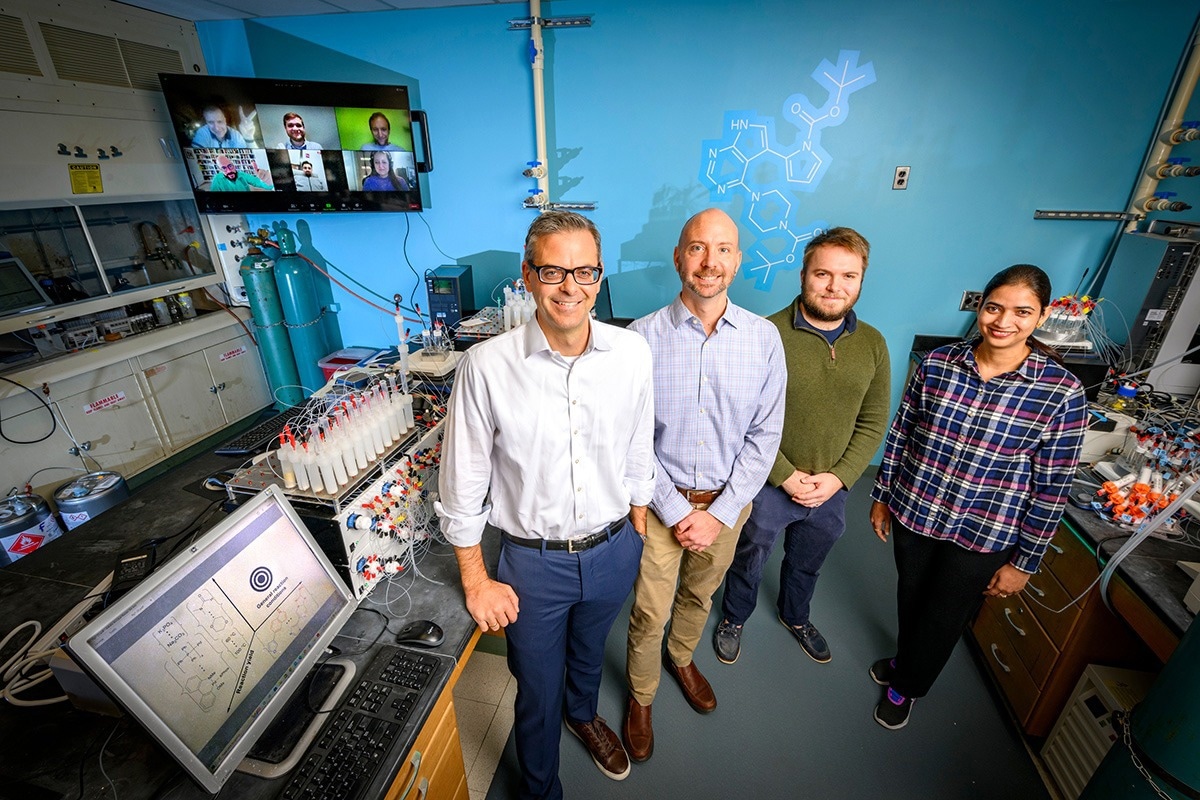Reviewed by Mila PereraOct 31 2022
A combination of artificial intelligence (AI), “building-block” chemistry, and a molecule-producing machine could find the most suitable general reaction circumstances for manufacturing chemicals crucial to materials and biomedical research.

Illinois researchers led an international team that combined powerful AI and a molecule-making machine to find the best conditions for automated complex chemistry. Pictured, from left: University of Illinois chemistry professor Martin D. Burke, materials science and engineering professor Charles M. Schroeder, graduate student Nicholas Angello and postdoctoral researcher Vandana Rathore. Pictured on the screen behind them are international collaborators, led by professors Bartosz A. Grzybowski and Alán Aspuru-Guzik. Image Credit: Fred Zwicky
This discovery could accelerate development and drug discovery, and automate and make complex chemistry accessible.
With machine-produced enhanced conditions, scientists at the University of Illinois Urbana-Champaign and collaborators in Canada and Poland magnified the average yield of a special, hard-to-optimize type of reaction connecting carbon atoms in pharmaceutically essential molecules.
The scientists state that their system offers a platform that also could be employed to discover broad conditions for other groups of reactions and solutions for correspondingly complicated issues. Their findings have been published in the journal Science.
Generality is critical for automation, and thus making molecular innovation accessible even to nonchemists. The challenge is the haystack of possible reaction conditions is astronomical, and the needle is hidden somewhere inside. By leveraging the power of artificial intelligence and building-block chemistry to create a feedback loop, we were able to shrink the haystack. And we found the needle.
Dr. Martin D. Burke, Study Co-Leader and professor of chemistry, University of Illinois
Dr. Martin D. Burke is also part of the Carle Illinois College of Medicine and is a medical doctor.
Automated synthesis devices for proteins and nucleic acids like DNA have transformed research and chemical manufacturing in those domains, but the scientists explain that several essential chemicals for clinical, manufacturing, pharmaceutical, and materials applications exist as tiny molecules with multifaceted structures.
Burke’s team has established the development of basic chemical building blocks for small molecules. His lab has also built an automated molecule-making machine that snaps together the building blocks to form a broad range of probable structures.
However, basic reaction circumstances to make the automated process widely applicable have remained intangible.
Traditionally, chemists customize the reaction conditions for each product they are trying to make. The problem is that this is a slow and very specialist-dependent process, and very hard to automate because the machine would have to be optimized every time. What we really want are conditions that work almost every time, no matter what two things you’re trying to snap together.
Dr. Martin D. Burke, Study Co-Leader and professor of chemistry, University of Illinois
An automated method with universal settings could help regulate how certain products are manufactured, tackling the issue of reproducibility, said Illinois postdoctoral researcher Vandana Rathore, the study’s co-first author.
Burke’s group partnered with a team guided by Bartosz A. Grzybowski at the Polish Academy of Sciences’ Institute for Organic Chemistry, Alán Aspuru-Guzik's team at the University of Toronto. Both are leaders in applying AI and machine learning to enhance chemical production. The researchers combined AI with the molecule machine to deliver instant feedback to the machine-learning platform.
“To distinguish good and bad you need to know something about the bad, but people only publish the successes,” Grzybowski said.
He continued to say that published studies often reflect conditions that are convenient or popular rather than the best, so a systematic approach that included diverse data and negative results was required.
First, the researchers tested the whole matrix of probable combinations using the building-block chemistry algorithm to categorize analogous reactions. Next, the AI conveyed commands, inputted to a machine in the Molecule Maker Lab situated in the Beckman Institute for Advanced Science and Technology at Illinois, to create characteristic reactions from each cluster. The data from those reactions were inputted back into the model, and the AI learned from the data and commanded more experiments from the molecule machine.
“We were looking to see two things: an increase in yield and a decrease in uncertainty, for a broad spectrum of reactions,” said Grzybowski, who now is at Ulsan Institute of Science and Technology in South Korea. “This loop continued without us having to intervene until the problem was solved. Figuring out the generalized conditions for protein-synthesis machines took 30 years. This took us two months.”
The process recognized circumstances that magnified the average yield of a complex group of reactions, called heteroaryl Suzuki-Miyaura coupling, critical for several biological and materials-relevant compounds.
There are all kinds of building block combinations that we didn't even study in our AI training, but because the AI had explored such a diverse space, it found good results even in those initially unexplored areas.
Nicholas H. Angello, Study Co-First Author, Graduate Student, University of Illinois
The machine-learning method illustrated in the article also could be applied to other broad domains of chemistry to discover the ideal reaction conditions for other kinds of small molecules or even larger organic polymers, the scientists say.
There are so many different materials classes that we want to know, target, and discover for different functional properties. The extension possibility of this approach to other similar reaction chemistry, other types of carbon-carbon links, is exciting.
Charles M. Schroeder, Study Co-Author and Professor of Materials Science and Engineering and Chemical and Biomolecular Engineering, University of Illinois
Charles M. Schroeder is also a Beckman Institute affiliate. This study was supported by the Defense Advanced Research Projects Agency and the National Science Foundation.
Journal Reference
Angello, N. H., et al. (2022) Closed-loop optimization of general reaction conditions for heteroaryl Suzuki-Miyaura coupling. Science. doi.org/10.1126/science.adc8743.